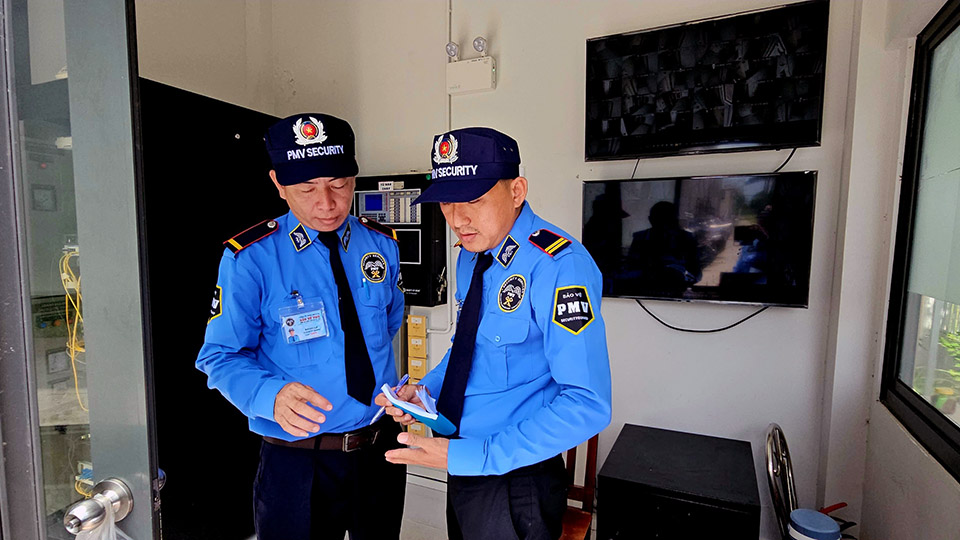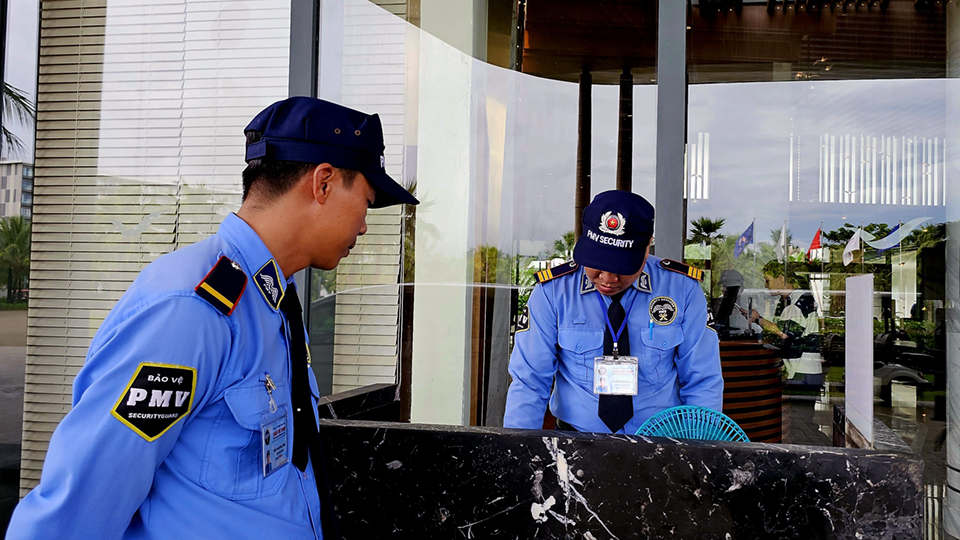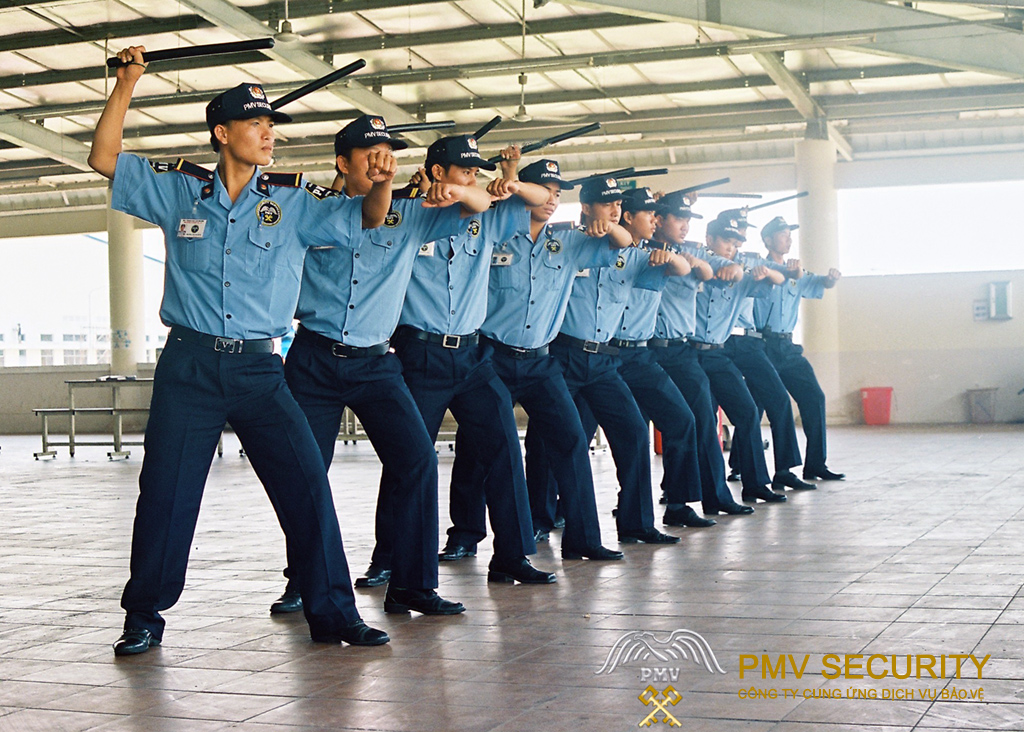PMV Security Services offers a wide range of operational security service, including physical security guards, VIP executive protection, investigations, security equipment, security audits, penetration testing, patrols, and much more. We are committed to providing safety and protection to our clients, contributing to the safe and stable development of society, and providing employment in the process of ensuring safety of lives and assets.
PMV Security Services is not just a company; it’s a brand that symbolizes trust and professionalism in the field of security services. Our vision is to become the leading security company all over the nation, making PMV Security a familiar brand among clients – a national trusted and professional brand of security and bodyguard services in Vietnam.
STANDARDS FOR OPERATIONAL SECURITY SERVICE GUARDS
Operational security service guards are essential for maintaining safety and order in various settings. The standards for these professionals typically include a comprehensive set of procedures and protocols to ensure consistent and effective performance. These standards often encompass.
- Professional conduct
- Uniformity
- Equipment usage
- Emergency response
- Reporting protocols
For instance, guards are expected to carry out regular patrols; monitor surveillance equipment, maintain logs, and respond to incidents with appropriate measures. Training in first aid and CPR; as well as familiarity with the legal limits of their authority, is also crucial. Adherence to these standards ensures that security guards are prepared to protect assets and individuals, and to act swiftly and appropriately in crisis situations.
IMPERATIVE DEMAND FOR CONSISTENCY AND INNOVATION FOR OPERATIONAL SECURITY SERVICES
In the realm of operational security service, the imperative for consistency and innovation is not just a demand; but a necessity for maintaining robust security postures in dynamic environments. The integration of Information Technology (IT) and Operational Technology (OT) is a strategic imperative for businesses seeking to thrive in the modern digital ecosystem. This convergence is essential for harnessing data-driven insights that empower businesses to unlock hidden efficiencies and align decisions with strategic goals.
COMPREHENSIVE MONITORING TOOLS
Comprehensive monitoring tools that provide real-time insights into both IT and OT operations; are crucial for identifying anomalies promptly and ensuring a consolidated view of operations.
CROSS -FUNCTIONAL TEAMS AND EXPERT CONSULTING
Cross-functional teams and expert consulting can facilitate the integration process; considering specific requirements and challenges; while expert consulting helps create a strategy aligned with industry standards. A unified security approach harmonizes security policies, access controls, and incident response procedures across IT and OT environments, which is vital for maintaining operational security service and resilience. As infrastructures diversify, new edges, technologies, and tools continue to expand the attack surface.
PMV SECURITY SYSTEMATIC SOLUTIONS
To address this, PMV security services has a single pane of glass management system to effectively manage risk and define consistent security policies throughout the entire infrastructure. The challenge lies in consolidating and integrating different solutions in various cloud environments to ensure a consistent cloud security policy. The evolution of security operations must also consider strategies for building an effective Security Operations Center (SOC); which involves real-time monitoring and investigation of security events to prevent, detect, and respond to physical threats and cyber threats using a combination of people, processes, and technologies.
METHODS OF PROVIDING OPERATIONAL SECURITY SERVICES
Operational security (OPSEC) is a critical aspect of protecting sensitive information within an organization. Here are some methods for providing operational security services:
– Data Identification: Clearly define and categorize sensitive data; such as intellectual property, financial records, and personal information of employees and customers.
– Threat Analysis: Analyze and identify potential threats; including both external cyber threats and internal risks such as employee negligence or malicious intent.
– Security Measures: Implement robust security measures, including firewalls, intrusion detection systems, and encryption, to protect against unauthorized access to sensitive data.
– Policy Development: Develop comprehensive security policies and procedures that outline the responsibilities of employees and the protocols for handling sensitive information.
An innovative mode of operation for a top-edge security service could involve integrating advanced Security Service Edge (SSE) solutions. These solutions typically combine zero trust network and movement access, zero tolerance to security threats. This approach allows for the enforcement of consistent security policies across an entire network; which is particularly beneficial for organizations with remote workforces and multiple branch offices.
IDENTIFICATION OF CLIENTS REQUIREMENTS
The identification of client requirements is a critical step for professional operational security service. It involves a thorough and systematic assessment of the client’s specific security needs and the potential risks they face. This process is essential to develop a tailored security plan that addresses the unique challenges and threats to the client’s operations. According to best practices, this includes understanding the client’s
- Operational context,
- Identifying assets that need protection,
- Assessing the threats and vulnerabilities,
- Determining the level of risk acceptable to the client.
A comprehensive approach often involves several layers of security measures, including physical security, information security, and personnel security, to ensure a robust defense against potential security breaches. Identifying client requirements is a crucial first step for any professional operational security service. Here’s a breakdown of how to effectively achieve this:
Establish Rapport and Communication
Meet and Greet: Schedule an initial meeting to build rapport with the client. This initial interaction helps set the tone for the entire engagement.
Active Listening: Pay close attention to the client’s concerns and priorities. Ask clarifying questions to ensure a clear understanding of their needs. Tailored Communication: Use clear and concise language that aligns with the client’s technical expertise.
- Needs Assessment:
Industry and Threat Landscape: Research the client’s industry and identify the typical security threats they face.
Specific Concerns; Ask the client about any recent security incidents or areas where they feel particularly vulnerable.
Compliance Requirements: Understand any relevant industry regulations or legal requirements that the client needs to comply with.
- Information Gathering Techniques:
Questionnaires: Develop targeted questionnaires to gather specific details about the client’s infrastructure, data security practices, and security posture.
Site Surveys (Optional): Depending on the client’s needs, conducting a physical or virtual site survey can provide valuable insights into their security posture.
Review of Existing Security Policies (Optional): If the client has existing security policies, reviewing them can provide a good starting point for understanding their security approach.
- Prioritization and Recommendation:
Risk Assessment: Analyze the gathered information to assess the client’s security risks.
Prioritize Needs: Based on the risk assessment, prioritize the client’s security needs and recommend appropriate solutions.

Operational security service and Identication of clients requirements
SELECTION AND TRAINING OF OPERATIONAL SECURITY SERVICE PERSONNEL
Selecting and training qualified personnel is vital for any operational security service. Here’s a breakdown steps for PMV Security services selection pattern:
SELECTION
Background Checks: Conduct thorough background checks to ensure candidates have a clean record and meet any legal requirements.
Experience and Skills: Evaluate relevant security experience, including prior military service, law enforcement experience, or experience in specific security sectors.
Security Clearances: Depending on the client’s needs, candidates might require security clearances for handling sensitive information.
Technical Skills: Assess technical skills relevant to the specific service offered. This may include knowledge of access control systems, surveillance technology, or cybersecurity tools.
Soft Skills: Emphasize strong soft skills like communication, observation, critical thinking, problem-solving, and the ability to work independently or as part of a team.
Integrity and Discretion: Look for candidates who demonstrate high levels of integrity, discretion, and a strong commitment to confidentiality.
Trained for operational security services
QUALITY MANAGEMENT OF OPERATIONAL SECURITY SERVICES
Delivering high-quality operational security services requires a robust quality management system (QMS). Here’s how to establish and maintain an effective QMS:
- Define Quality Objectives:
Client Focus: Set clear objectives focused on exceeding client expectations and achieving their desired security outcomes.
Continuous Improvement: Establish a culture of continuous improvement by regularly reviewing and refining security processes.
Compliance: Ensure all services comply with relevant industry standards, regulations, and legal requirements.
- Develop a Quality Management System Framework:
Plan-Do-Check-Act (PDCA) Cycle: Implement the PDCA cycle as a foundational framework for your QMS. This involves planning security services, implementing them, checking their effectiveness, and taking corrective actions for improvement.
Standardized Processes: Develop and document standardized operational procedures (SOPs) for all security services offered. This ensures consistency and reduces the risk of errors.
Performance Measurement: Define key performance indicators (KPIs) to measure the effectiveness of your security services. KPIs could include incident response times, security awareness training completion rates, or client satisfaction metrics.
- Implementation and Monitoring:
Training and Awareness: Ensure all personnel are adequately trained on the QMS principles, SOPs, and relevant KPIs.
Internal Audits: Conduct regular internal audits to identify areas for improvement and ensure adherence to established procedures.
Management Reviews; Schedule periodic management reviews to evaluate the overall effectiveness of the QMS and make strategic decisions for improvement.

Technological innovation for operational security service – PMV security services
CONCLUSION
In conclusion, the evolution of operational security services has been pivotal in safeguarding organizational assets against increasingly sophisticated cyber threats. An effective Security Operations Center (SOC) is integral to this defense, utilizing a blend of expert personnel, processes, and technology to monitor, detect, and respond to incidents. As cyber threats continue to evolve, so must the strategies and tools employed by SOCs to stay ahead of potential attackers and protect sensitive information.
Micah A. (MR).
Professional Security Expat – PMV Security Services










👌🏽